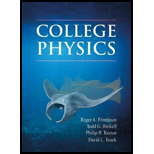
Concept explainers
(a)
The speed each cell would need when very far away from each other to get close enough to just touch.
Answer to Problem 38QAP
The speed each cell would need when very far away from each other to get close enough to just touch is
Explanation of Solution
Given info:
Mass of each cell is,
Charge on first cell is,
Charge on second cell is,
Diameter of each cell is,
Formula used:
Formula for the electric potential energy for two point charges is,
Calculation:
When the two cells are close enough to just touch, their kinetic energy will be zero. So, they have only electric potential energy at this point.
When the two cells are very far away from each other, their electric potential energy will be zero. So, they have only kinetic energy in this situation.
The kinetic energy of each cell when they are very far away can be calculated as,
The electric potential energy of two cells when they get close enough to just touch can be calculated as,
From the conservation of energy, we get
Substituting the given values in the above equation, we get
Conclusion:
Thus, the speed each cell would need when very far away from each other to get close enough to just touch is
(b)
The magnitude of the maximum acceleration of the each cell.
Answer to Problem 38QAP
The magnitude of the maximum acceleration of the each cell is
Explanation of Solution
Given info:
Mass of each cell is,
Charge on first cell is,
Charge on second cell is,
Diameter of each cell is,
Formula used:
The formula for the electrostatic force between two charged particles is given as,
Calculation:
Substituting the given values in the above equation, we get
The maximum acceleration of each cell can be calculated as,
Conclusion:
Thus, the magnitude of the maximum acceleration of the each cell is
Want to see more full solutions like this?
Chapter 17 Solutions
COLLEGE PHYSICS
- 3. If the force of gravity stopped acting on the planets in our solar system, what would happen? a) They would spiral slowly towards the sun. b) They would continue in straight lines tangent to their orbits. c) They would continue to orbit the sun. d) They would fly straight away from the sun. e) They would spiral slowly away from the sun. 4. 1 The free-body diagram of a wagon being pulled along a horizontal surface is best represented by A F N B C 0 Ꭰ FN E a) A b) B c) C app app The app 10 app d) e) ס ח D E 10 apparrow_forwardPls help ASAParrow_forwardPls help asaparrow_forward
- Pls help asaparrow_forwardThe acceleration of an object sliding along a frictionless ramp is inclined at an angle 0 is 9. a) g tano b) g cose c) g sino 10. d) g e) zero A 1.5 kg cart is pulled with a force of 7.3 N at an angle of 40° above the horizontal. If a kinetic friction force of 3.2 N acts against the motion, the cart's acceleration along the horizontal surface will be a) 5.0 m/s² b) 1.6 m/s² c) 2.4 m/s² 11. d) 1.0 m/s² e) 2.7 m/s² What is the net force acting on an object with a mass of 10 kg moving at a constant velocity of 10 m/s [North]? a) 100 N [North] b) 100 N [South] 10 N [North} d) 10 N [South] e) None of these.arrow_forwardModified True/False - indicate whether the sentence or statement is true or false. If the statement is false, correct the statement to make it true. 12. An object in uniform circular motion has a constant velocity while experiencing centripetal acceleration. 13. An object travelling in uniform circular motion experiences an outward centrifugal force that tends to pull the object out of the circular path. 14. An object with less inertia can resist changes in motion more than an object with more inertia. 15. For an object sliding on a horizontal surface with a horizontal applied force, the frictional force will always increase as the applied force increases.arrow_forward
 Physics for Scientists and Engineers, Technology ...PhysicsISBN:9781305116399Author:Raymond A. Serway, John W. JewettPublisher:Cengage Learning
Physics for Scientists and Engineers, Technology ...PhysicsISBN:9781305116399Author:Raymond A. Serway, John W. JewettPublisher:Cengage Learning Physics for Scientists and Engineers: Foundations...PhysicsISBN:9781133939146Author:Katz, Debora M.Publisher:Cengage Learning
Physics for Scientists and Engineers: Foundations...PhysicsISBN:9781133939146Author:Katz, Debora M.Publisher:Cengage Learning Principles of Physics: A Calculus-Based TextPhysicsISBN:9781133104261Author:Raymond A. Serway, John W. JewettPublisher:Cengage Learning
Principles of Physics: A Calculus-Based TextPhysicsISBN:9781133104261Author:Raymond A. Serway, John W. JewettPublisher:Cengage Learning
 College PhysicsPhysicsISBN:9781305952300Author:Raymond A. Serway, Chris VuillePublisher:Cengage Learning
College PhysicsPhysicsISBN:9781305952300Author:Raymond A. Serway, Chris VuillePublisher:Cengage Learning Physics for Scientists and EngineersPhysicsISBN:9781337553278Author:Raymond A. Serway, John W. JewettPublisher:Cengage Learning
Physics for Scientists and EngineersPhysicsISBN:9781337553278Author:Raymond A. Serway, John W. JewettPublisher:Cengage Learning





